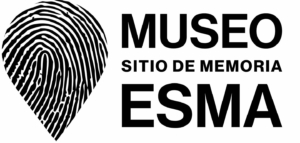In the context of the activities organized for the nomination of the ESMA Museum and Site of Memory – Former Clandestine Center of Detention, Torture and Extermination, the last day of teachers’ training took place on October 18th, 2019, under the title «Schools, Memory and Heritage – More Tools for the Recent Past». Organized by the Museum and the Argentina National Commission for Cooperation with UNESCO (CONAPLU), the activity welcomed more than 50 teachers who took the guided tour and participated in a workshop-conversation.
The welcome speech was given by Sebastián Schonfeld, Director of Institutional Relations at the ESMA Museum and Site of Memory, who thanked the teachers for their presence. «The idea of these events is to address the issue of Memory from a different perspective: heritage,» he said.
Participants of the activity included Florencia Buonomo and Silvia Seijas in representation of CONAPLU; Cecilia Flachsland and Daiana Gerschfeld from the Ministry of Education’s program of Education and Memory, Cecilia Cavallo, from the Museum’s Education team, and Mauricio Cohen Salama, Coordinator of the Work Plan for the Museum’s nomination to become a Unesco World Heritage Site.
Buonomo gave the first presentation, in which she trained participants on the main notions around World Heritage, the connection between Education and Heritage, the conventions and criteria by which material and immaterial assets are labeled as cultural, natural or mixed heritage assets. «Unesco is the United Nations’ agency specialized in education, culture, social sciences, exact sciences and communication. Ever since Argentina committed itself to the United Nations we work to abide by the programs and conventions we signed up to», she explained.
The Role of Schools, Professors, and Teachers’ Unions
Cohen Salama presented the progress in the nomination and stressed that «the outstanding universal value of the Museum lies in the fact that it is a testimony and a symbol of State Terrorism based on the forced disappearance of people, as well as a testimony and a symbol of the power of persuasion and social consensus as means to obtain justice».
Before the end, Flaschland talked about her experience visiting ESMA together with a group of students back in 2007, to illustrate the processes and debates around the way to transmit State Terrorism in an educational context. «Schools, professors, and also teachers unions have had an essential role in the build up of what we will call a World Heritage. In my first visit, the place wasn’t marked with signs yet, there were areas one couldn’t access, and some students were angry about it. They said this place should be shared with everyone. It was a disruptive moment in the place, which back then was empty; everything was yet to be built. Today we are discussing this, which means that what was built is huge», she highlighted.
To close the day, the participants took a tour of the Museum’s permanent exhibition joined by the Museum’s Executive Director and head of the nomination project Alejandra Naftal, who invited everyone to share their experience with colleagues, friends and family members, and to promote the visits to the Museum within their workplaces.



